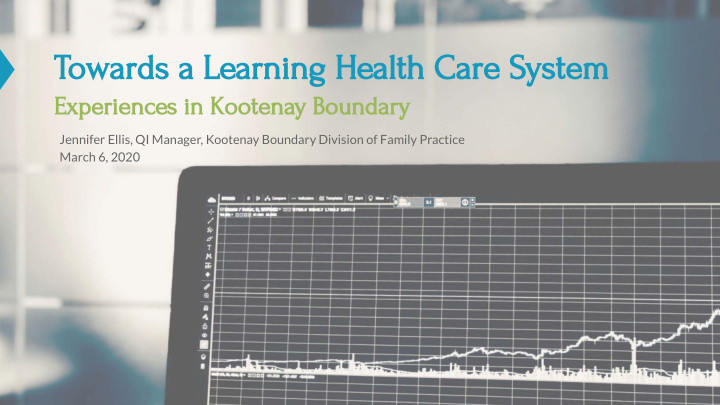



Towards a Learning Health Care System Experiences in Kootenay Boundary Jennifer Ellis, QI Manager, Kootenay Boundary Division of Family Practice March 6, 2020
Kootenay Boundary 78,000 people 93 GPs and 6 NPs in family practice 49 ED physicians, hospitalists, locums, GPs/NPs in focused practice 50 specialists 26 primary care clinics 3 hospitals with inpatient beds 3 health care centres with EDs open in daytime only
A Learning Healthcare System “science, informatics, incentives, and culture are aligned for continuous improvement and innovation, with best practices seamlessly embedded in the delivery process and new knowledge captured as an integral by-product of the delivery experience.” Institute of Medicine, 2015
Principles of a Learning System in KB QI not QA Data literacy based Voluntary but value-add The data is a conversation starter. T alk about the data. Explain what Bring people along by helping them to see Establish a blame-free culture that things mean and how they were the value of the work and information. Get allows falling forward. measured. Discuss uncertainty. feedback on approaches. Data and tool democracy Imperfection is expected Su�cient resourcing And accepted. The data is messy. Share data openly with safeguards. Data collection, analysis and The tools are imperfect. Some Build and share a library of tools to sharing takes time and money. things seem unmeasurable. But enable shared language and common This cannot be done off the side there is a need to move forward. approaches. of a desk.
Principles of a Learning System in KB Measure twice (or more) Outcomes focus Ground in the literature Understand what you are trying to Use a diverse set of measures to You're probably not the �rst to try to achieve and how you will know change to triangulate, tell a robust story do something. Learn what you can is an improvement. Logic models! and account for the unexpected. from the experiences of others. Relationships enable Decentralization and Disaggregate data Self-management Trust is integral to data sharing, data The data must be as disaggregate collection and discussions about A learning system cannot be top down. as possible enabling people to see outcomes, progress and mistakes. Ideas must �ow up and down and local themselves within it while still people must be empowered to self- preserving trust and privacy. manage.
Structures of a Learning System: People 01 Embedded evaluators and QI coordinators Builds relationships and trust Keeps the focus on data, outcomes and learning Enables formative evaluation and regular feedback loops 02 Protected budgets for QI and evaluation Creates buffer and allows for experimentation Ensures evaluation always happens Evaluation, QI and data sharing becomes an organizational norm 03 Evaluation and QI roles separate from project management Project managers do not plan or execute evaluations and evaluators/QI coordinators do not project manage 04 Physician leaders in data sharing and literacy "I'll show you mine, if you show me yours" - normalizes results Sessional supported
Structures of a Learning System: Tools 05 Regular data and QI "events" part of all initiatives Learning labs and Regional QI meetings establish regular re�ection Facilitate data sharing, data democracy and data literacy Allow for a refocusing of action around outcomes and data 06 Regular "Report on Outcomes" with 20 indicators Keeps focus on outcome indicators vs. process or output indicators Opportunity to review what we know, and explore what if any utility that provides 07 Evaluation and QI tools and frameworks Toolkit of frameworks, surveys, consent forms, reports, logic models, info sharing agreements and indicators developed collaboratively 08 Routine data collection using standardized tools Annual member survey, patient surveys, project check-ins Makes data collection just a part of doing business Moving towards more automated EMR data analytics
Structures of a Learning System: Partners 09 Commitment to and funding for sharing learnings Commitment to sharing �ndings, tools developed, approaches and experiences to multiple audiences 10 Data relationships and communities of practice Establishing partnerships to access data, share data and collect data Communities of practice enable learning and sharing of tools 11 Partnerships with research organizations Expand our reach, bring in new expertise and enable innovative projects 12 Provincial working groups and pilots Ability to engage in provincial discussions Opportunity trial new tools and approaches
Culture enables structures and Structures create culture
Kootenay Boundary Learning System Culture of Learning Data Partnerships Regular Data and and Communities QI not QA Embedded QI QI Events of Practice Coordinators and Evaluators Voluntary but Sharing Robust Toolbox Value Add Learnings Protected and Reports on Sufficient Partnerships Outcome Outcomes Budgets with research Focus organizations Regular and Physician Self- Automated Data Leaders Management Pilots Collection
Kootenay Boundary Vignette: PCN Culture of Learning QI and Evaluation IH Data QI not QA QI Coordinators Framework Relationship and Coaches for 12 outcomes and 37 IH PCN Evaluation indicators each clinic Voluntary, but Community of Patient Value Add Practice Experience Survey 0.8 FTE n=1500 for QI Eval for Outcome Research 12 clinics Tools for measuring Focus projects with access, team & Clinic QI Leads UBC and UVic PROMS Self- PCN Learning Lab Management PCN Clinic Leads MoH Data CPCSSN for EMR Linking Pilot analytics
Building a Learning Health Care System Provincially Create a Make data Establish Fund internal toolkit with easily and external enabling standardized data analysts accessible frameworks measures Support learning Enable top Incentivize data Establish key networks and down and collection and indicators communities of bottom up re�ection collaboratively learning practice Establish Eliminate data Include all Allow for mechanisms silos and stakeholders local for knowledge enable data innovation succession linking
Recommend
More recommend